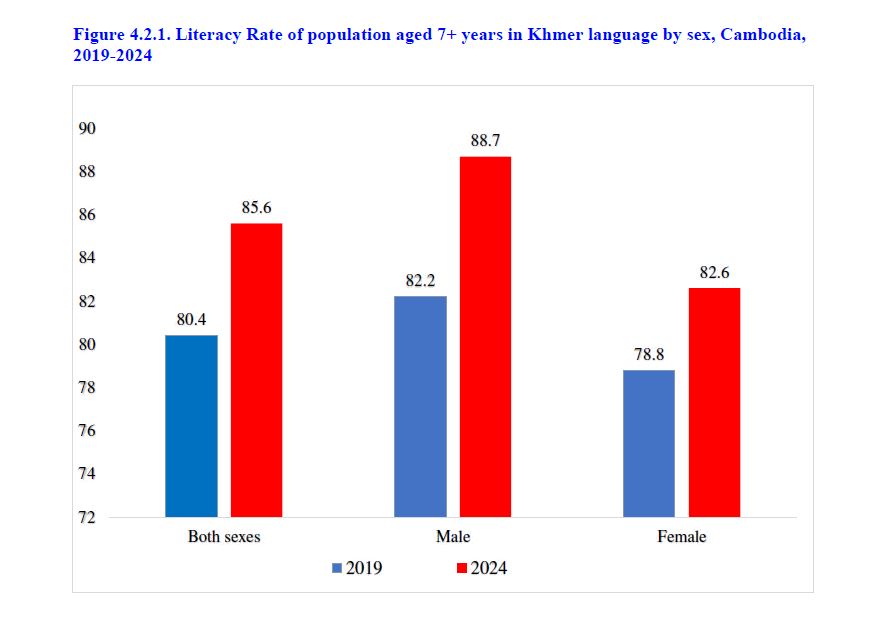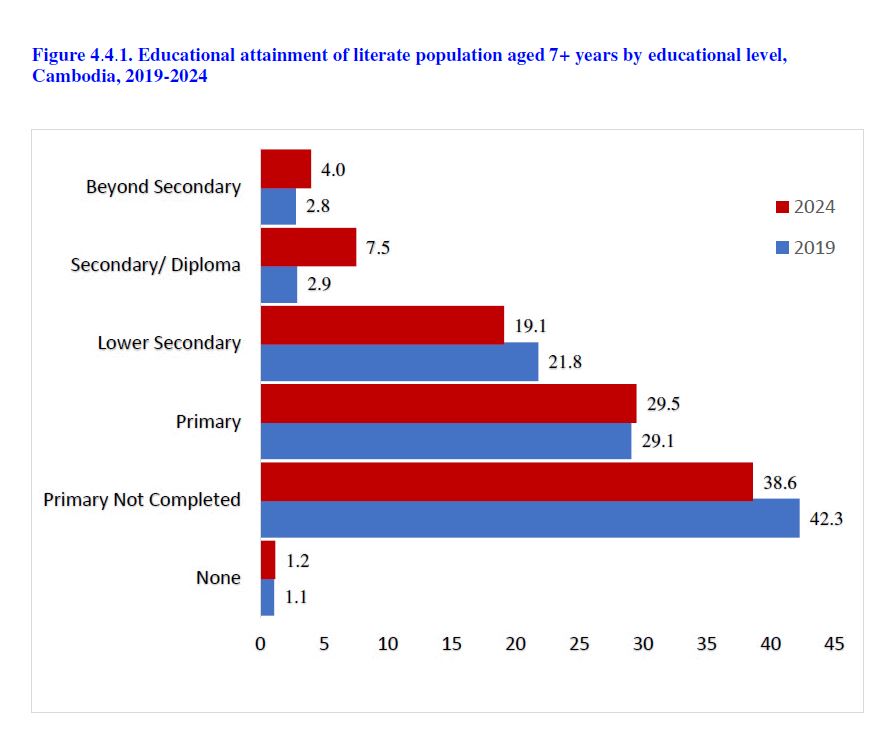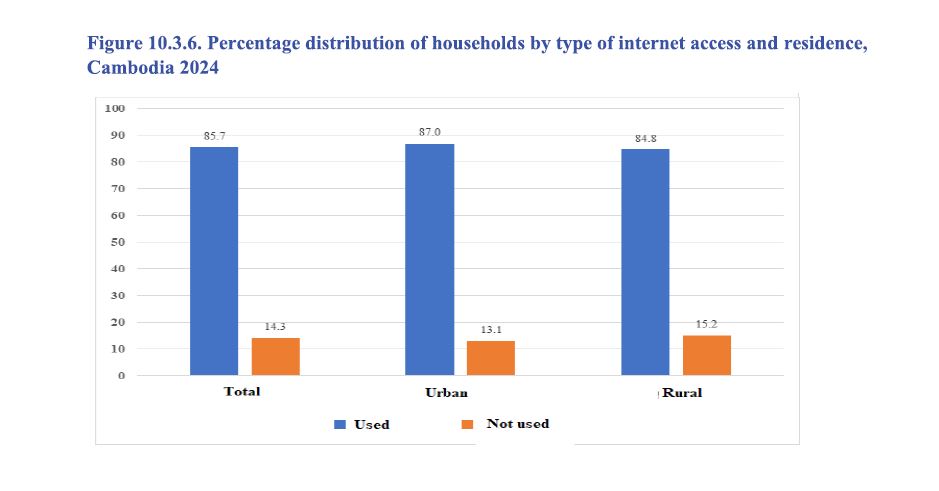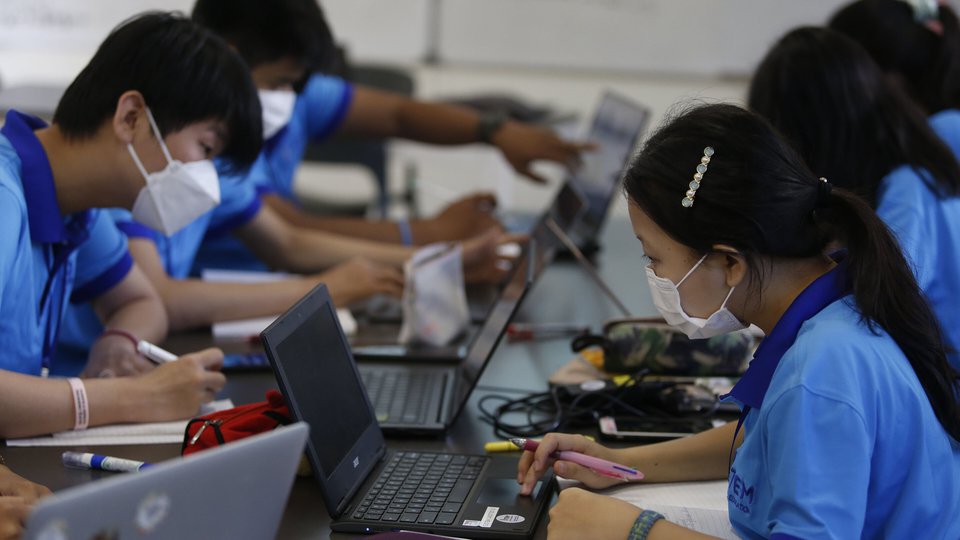Cambodia Investment Review
A new government report from the Cambodia Inter-Censal Population Survey 2024 (CIPS 2024) reveals steady progress in literacy and education levels across the country—offering positive signals for businesses and investors seeking to tap into Cambodia’s growing human capital and workforce potential.
The findings, released as part of the Kingdom’s official population and development data collection, show that improvements in literacy, bilingual skills, and vocational qualifications are aligning with Cambodia’s long-term economic ambitions outlined in the National Strategic Development Plan 2024-2028 and the Cambodian Sustainable Development Goals (CSDGs).
Literacy Gains Fuel a More Capable Workforce
The report highlights that the national literacy rate in the Khmer language for people aged seven and older rose to 85.6% in 2024, up from 80.4% in 2019. Male literacy reached 88.7%, while female literacy improved to 82.6%, reflecting steady gains despite persisting gender gaps, particularly in rural areas.
Read More: Opinion: How Can Cambodia Keep Women in the Workforce After its LDC Graduation in 2029?
More significant for future business development, the percentage of Cambodians literate in both Khmer and English more than doubled over the past five years—jumping from 5.1% in 2019 to 11.7% in 2024. Urban areas recorded even higher bilingual literacy rates at 16.8%. This trend reflects Cambodia’s increasing integration with regional and international markets, where English language skills are critical for sectors such as finance, technology, tourism, and professional services.
The report notes that the growing bilingual population will strengthen Cambodia’s competitiveness, particularly for foreign investors seeking skilled local talent capable of operating in global environments.

Stronger Educational Attainment Supports Skilled Sectors
CIPS 2024 also reported that educational attainment levels have improved nationwide. Among those who attended school, 7.5% completed secondary or diploma programs, a sharp rise from 2.9% in 2019. Additionally, the proportion of the population achieving post-secondary qualifications grew from 2.8% to 4.0%.
At the same time, the share of Cambodians who have not completed primary education fell from 42.3% to 38.6%. The report indicates that these positive shifts are helping to create a more educated labor force, which is critical for Cambodia’s move towards higher value-added industries.
The data show that urban areas continue to outperform rural areas in terms of educational achievement, creating opportunities for businesses focused on cities like Phnom Penh, Siem Reap, and Sihanoukville. However, the rural-urban education gap also points to areas where targeted investments in workforce development could generate significant long-term returns.

Technical and Vocational Training Expands Skilled Labor Pool
The government report emphasizes Cambodia’s progress in technical and vocational education and training (TVET), with growing numbers of workers certified across three levels of qualifications.
Among those aged 17 and above, nearly 30,000 people have completed Technical and Vocational Qualification Level 3 programs, positioning them for skilled employment in industries like construction, manufacturing, and engineering.
The report also records over 9,000 people certified at Level 1 and nearly 7,000 at Level 2, indicating the country’s growing capacity to supply technically proficient workers to meet industrial demands. This progress reflects the government’s ongoing efforts to align workforce development with Cambodia’s industrialization goals and private sector needs.

Business and Investment Implications
The CIPS 2024 results suggest that Cambodia is making meaningful strides toward building a more skilled, literate, and competitive labor force. The report points out that youth enrollment remains strong, with 94.1% of children aged 6-11 and 90.8% of those aged 12-14 currently attending school.
However, school attendance drops significantly from age 15 onwards, often due to economic pressures driving young people into the workforce early. The government report notes this trend presents an opportunity for the private sector to engage in education-linked employment programs or vocational training to bridge this gap.
With Cambodia prioritizing education and vocational skills development, businesses—particularly those in manufacturing, digital services, hospitality, and export-oriented sectors—stand to benefit from the country’s increasingly capable workforce. Investors focusing on urban areas will find more immediate access to skilled talent, while rural regions represent untapped potential for long-term development.
The government report concludes that continued progress in literacy and education will be critical to Cambodia’s ambitions to become a regional industrial hub and attract higher-quality investments in the coming years.





